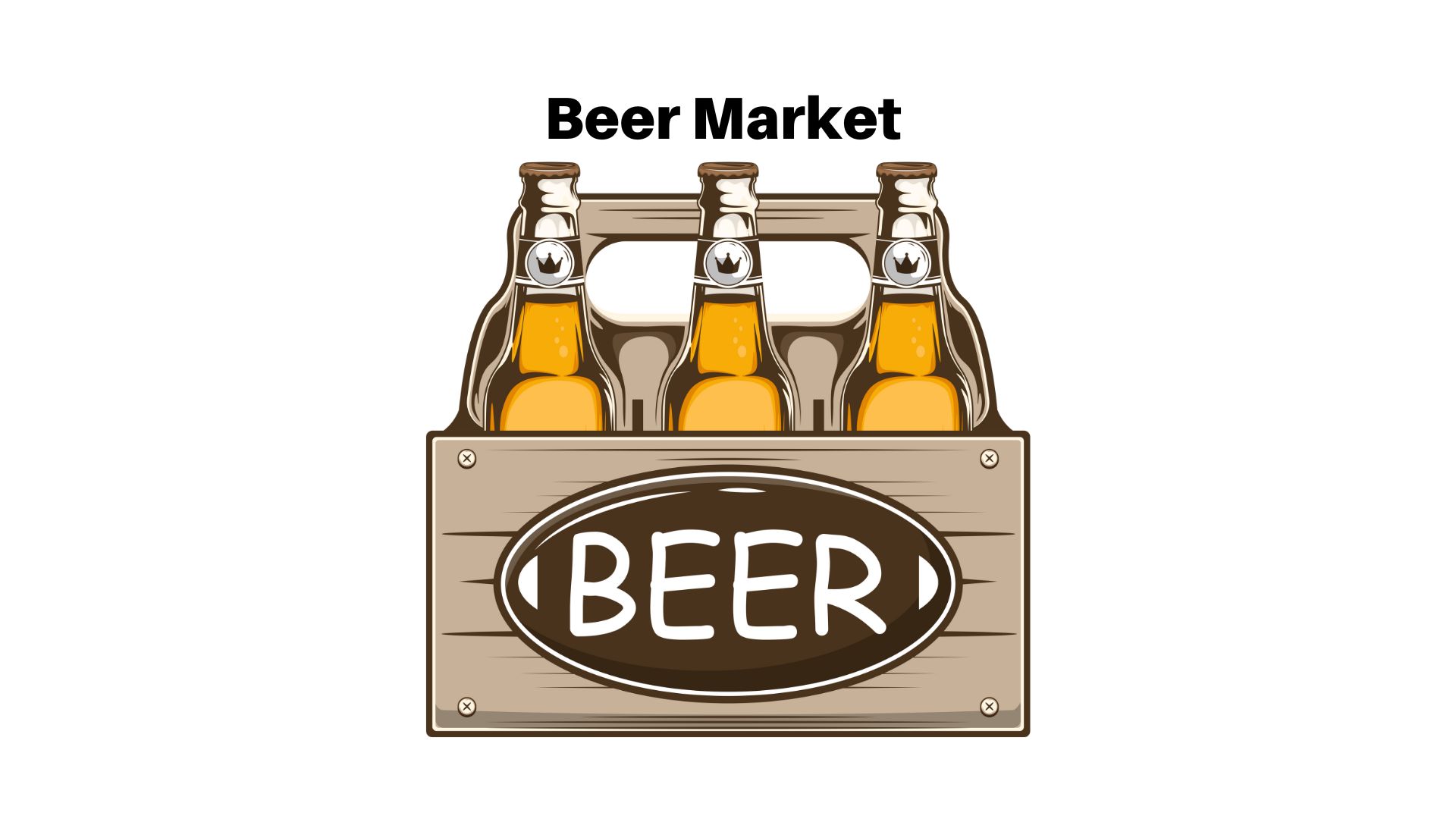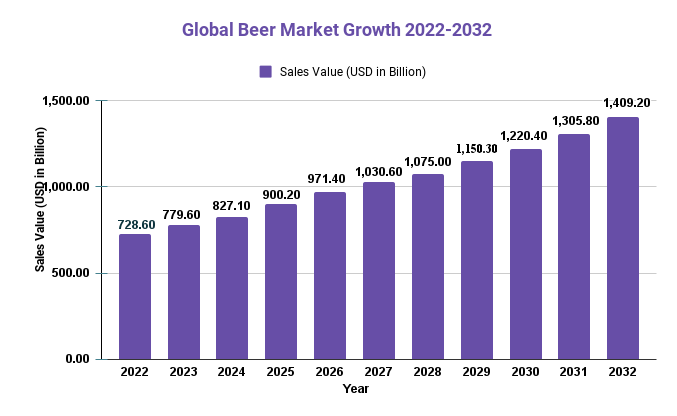CAGR of 7% For Beer Market to Gain USD 1409.20 billion By 2032 | Vendors Analysis (Ingenico, Verifone) By 2032

Page Contents
Market Overview
Published Via 11Press: The global beer market is forecast to expand at a compound annual growth rate (CAGR) of 7% between 2022-2032, driven by rising popularity among younger populations, rising disposable income levels, and the expansion of microbreweries around the world. The beer market remains fiercely competitive with many players including major international brands and local microbreweries competing for market share.
In 2022, the beer market was estimated USD 728.6 billion with a compound annual growth rate (CAGR) between 2022 and 2032 of 7%.
Geographically, the Asia-Pacific region is the leading beer market, accounting for over 40% of the global market share in 2020. This is due to its large and rapidly growing population as well as growing interest in beer in countries like China, Japan, and India. Lagers remain the most popular type of beer at 85% share worldwide; however, craft beer has seen a resurgence with small batches brewed with unique flavors and ingredients.
Overall, the beer market is a dynamic and evolving industry that is driven by shifting consumer preferences, economic conditions, and regulatory requirements. Companies must adjust and innovate in order to remain competitive and meet consumers' demands.
Drivers, trends, and challenges have an impact on market dynamics, which can impact businesses. Request for PDF sample report

Key Takeaways
- The global beer market is projected to experience a compound annual growth rate (CAGR) of 7% during the forecast period (2022-2032).
- This growth is being fuelled by the increasing popularity of beer among younger populations, rising disposable income levels, and an expanding number of microbreweries around the world.
- The beer market is highly competitive, featuring a multitude of players – from major international brands to local microbreweries.
- Asia-Pacific is forecasted to be the fastest-growing region in the beer market during the forecast period, due to rising disposable income and the growing popularity of beer among countries like China and India.
- The major players in the beer market include Anheuser-Busch InBev, Heineken NV, Carlsberg Group, SABMiller plc, and Diageo plc.
Regional Snapshot
North America leads the beer market, followed by Europe and Asia-Pacific. Asia-Pacific is expected to experience rapid growth over the forecast period due to rising disposable income levels and an increasing preference for beer among countries such as China and India. Europe too is expected to experience substantial expansion due to growing demand for craft beer and an influx of microbreweries in the region.
Drivers
- Growing disposable income: As disposable income rises, consumers tend to invest more in luxury items like beer – this could fuel the growth of the market.
- Craft beer's growing popularity: Craft beer's demand has been driven up due to its distinctive flavors and ingredients, driving growth in the overall beer market.
- Expansion of microbreweries: Microbreweries are becoming increasingly popular, offering consumers a distinctive drinking experience and fueling the growth of the beer market.
- Urbanization-Driven Growth in Beer Market: As more people move into urban centers, demand for beer has been on the rise, fuelling growth in this sector of the market.
Restraints
- Government Regulations: Government regulations can restrict the sale and distribution of beer, restricting the market growth.
- Health Concerns: Drinking too much beer may have negative health effects that lead to decreased demand for the product and ultimately slow growth in this segment.
- Competition from Other Alcoholic Beverages: The beer market faces stiff competition from other alcoholic beverages such as wine and spirits, which could limit its growth potential.
- The volatility of Raw Material Prices: Unpredictable changes in the prices of materials used in beer production can have an adverse effect on profitability and restrict market expansion.
Opportunities
- Craft Beer's Growing Popularity: Craft beer is experiencing a meteoric rise in popularity due to its distinctive flavors, inventive recipes, and locally sourced ingredients. This presents smaller breweries with an opportunity to gain market share and compete against larger beer companies.
- Growing Demand for Low-Alcohol and Non-Alcoholic Beer: With the current trend towards healthier lifestyles and moderation in alcohol consumption, there has been an uptick in demand for low-alcohol and non-alcoholic beer. This presents beer companies with an opportunity to diversify their product offerings and cater to this market.
- Rising Disposable Incomes: As disposable incomes increase, consumers are more willing to spend on premium and higher-priced beer products. This presents a business opportunity for beer companies to introduce more premium offerings and cater to affluent audiences.
Challenges
- Competition from other alcoholic beverages: Beer faces stiff competition from wine and spirits, among other types of alcoholic drinks. Beer companies need to find ways to differentiate their products and appeal to those who may prefer other types of alcohol.
- Regulatory Challenges: Beer companies must navigate complex regulations related to alcohol production, marketing, and distribution. This can present a problem for smaller breweries that may not have the resources to comply with these requirements.
- Sustainability Issues: Consumers are becoming increasingly concerned about the environmental effects of beer production, such as water usage and greenhouse gas emissions. Beer companies must address these worries by adopting sustainable production practices.
Recent Developments
- Rise of Hard Seltzers: Hard seltzers, which are flavored alcoholic beverages made with sparkling water, have seen an unprecedented surge in popularity recently. This has spurred increased competition within the alcoholic beverage market and even led some beer companies to launch their own versions of hard seltzers.
- Increased Focus on Health and Wellness: Beer companies are offering low-alcohol and non-alcoholic beer options to attract those seeking healthier beverages. Some even incorporate functional ingredients like probiotics and vitamins into their products for added benefits.
- Adoption of Technology: Beer companies are embracing technology to enhance production efficiency, quality assurance, and distribution. This includes using automation and data analytics to streamline operations and enhance supply chain management.
Key Market Segments
Type
- Twopenny
- Brown Beers
- Dark Beer
Application
- Household
- The Hotel
- KTV
Key Market Players
- TsingTao
- INDIO
- Heineken
- Coors Light
- Brahma
- Hardin
- Yanjing
- Skol
- Budweiser
- Bud Light
- Snow
- Kindfisher
- STROHS
- TECATE
- MGD
Report Scope
| Report Attribute | Details |
| The market size value in 2022 | USD 728.6 Bn |
| Revenue forecast by 2032 | USD 1,409.2 Bn |
| Growth Rate | CAGR Of 7% |
| Regions Covered | North America, Europe, Asia Pacific, Latin America, and Middle East & Africa, and Rest of the World |
| Historical Years | 2017-2022 |
| Base Year | 2022 |
| Estimated Year | 2023 |
| Short-Term Projection Year | 2028 |
| Long-Term Projected Year | 2032 |
Frequently Asked Questions
Q: What is the global beer market size?
A: A report estimates that it was valued at USD 728.6 billion in 2022 and is projected to reach a value of USD 1,409.2 billion by 2032, growing at an annual compound growth rate (CAGR) of 7% from 2022-2032.
Q: What is craft beer?
A: Craft beer refers to beer produced by small, independent breweries using traditional techniques and high-quality, locally sourced ingredients. Craft beer stands out for its distinctive flavors and inventive recipes.
Q: What is non-alcoholic beer?
A: Non-alcoholic beer refers to any beer with its alcohol content reduced below 0.5% ABV. Non-alcoholic beer appeals to those seeking healthier options or who want to enjoy beer without the alcohol kick.
Q: What is a hard seltzer?
A: Hard seltzers are an alcoholic beverages made with sparkling water, alcohol, and natural fruit flavors. In recent years they have gained popularity due to their lower calorie and sugar content compared to other alcoholic beverages.
The team behind market.us, marketresearch.biz, market.biz and more. Our purpose is to keep our customers ahead of the game with regard to the markets. They may fluctuate up or down, but we will help you to stay ahead of the curve in these market fluctuations. Our consistent growth and ability to deliver in-depth analyses and market insight has engaged genuine market players. They have faith in us to offer the data and information they require to make balanced and decisive marketing decisions.